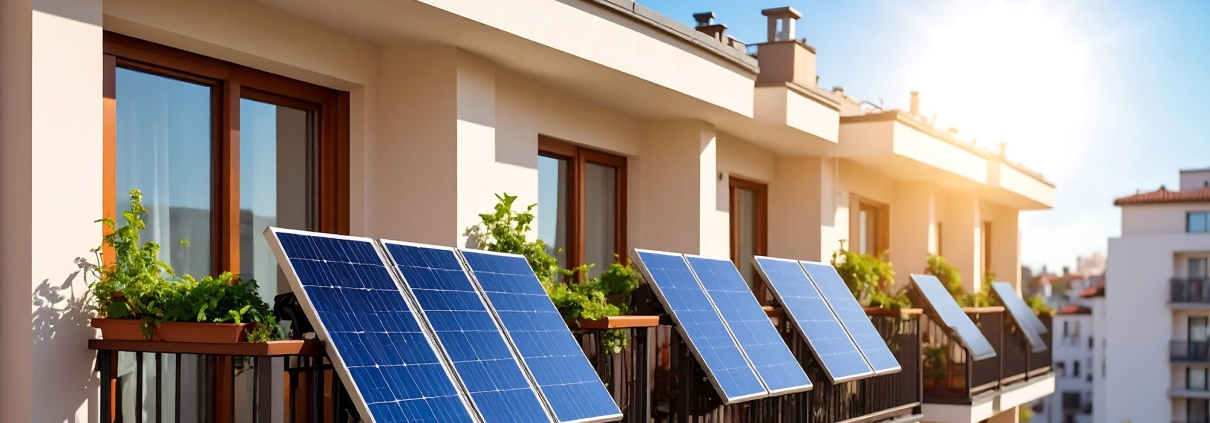Balcony Solar Systems: How to Power Your Urban Home Efficiently and Safely
Introduction
Urban living doesn’t have to mean relying solely on the grid. With rising electricity costs, frequent outages, and growing environmental awareness, more North American homeowners are exploring balcony solar systems as a practical, space-efficient way to generate and store electricity.
These compact solar setups allow residents in apartments, condos, or homes with limited roof space to harness renewable energy, reduce utility bills, and build resilience against outages — all without a full rooftop installation.
Why Balcony Solar Systems Are Gaining Popularity
Several factors drive the interest in small-scale, balcony-mounted solar panels:
- Limited space in urban areas: Not every apartment has rooftop access, but balconies are often underutilized spaces.
- Growing electricity costs: Even a modest 200–400 W system can offset daily energy usage for small electronics and appliances.
- Environmental awareness: Users want to reduce carbon footprints without committing to large-scale solar.
- Ease of installation: Modern plug-and-play systems can be installed without professional contractors for off-grid or self-consumption setups.
💡 Balcony solar is not just about energy savings — it’s about increasing self-reliance and minimizing dependence on the grid.
Key Components and How to Choose Them
A typical balcony solar system includes:
- Solar Panels
- Usually compact (100–400 W) to fit railing or floor-mounted setups.
- High-efficiency monocrystalline panels are preferred for limited space.
- Inverter / Power Converter
- Converts DC from panels into AC for household devices.
- Some plug-and-play systems include integrated micro-inverters.
- Battery / Energy Storage
- Essential for storing energy for evening use or during outages.
- High-quality lithium batteries are recommended for long life and consistent performance.
- For users seeking cost-effective, bulk options, wholesale lithium batteries can provide reliable solutions for residential storage systems.
- Monitoring & Safety Features
- Smart monitoring apps track energy production, consumption, and battery health.
- UL/CE certifications ensure compliance with electrical safety standards.
Regulations and Approval in North America
Even for small, balcony-mounted solar setups, it’s important to understand legal and safety requirements:
- Building and Electrical Codes: Some cities require that any solar installation, even small plug-in systems, comply with the National Electrical Code (NEC) for wiring and safety.
- Permits & Utility Notification:
- If the system is grid-tied, you must typically apply for interconnection approval from your utility company.
- Off-grid, self-consumption systems often do not require permits, but local building codes and HOA (Homeowners’ Association) rules may still apply.
- Power Export Restrictions: Most small balcony systems are designed not to feed electricity back to the grid, simplifying compliance.
- Insurance & Liability: Check with your homeowner’s or renter’s insurance for coverage of installed panels and batteries.
📌 By understanding local regulations and safety standards, you can avoid legal issues and ensure a secure installation.
Cost, Incentives, and ROI
Balcony solar systems are not just an energy solution — they can be a smart financial investment:
- System Cost: Small balcony setups range from $500–$2,500 depending on panel wattage and storage capacity.
- Federal & State Incentives:
- Some states offer rebates for residential solar systems, even for compact installations.
- Federal tax credits (e.g., Investment Tax Credit, ITC) may apply if paired with larger battery storage systems.
- Payback Period: Typical ROI can range from 3–7 years, depending on local utility rates, solar exposure, and battery storage use.
💡 Pairing a balcony solar system with a high-quality, stackable residential battery, like the High Voltage Stackable Residential Energy Storage System, can extend energy independence and improve ROI by storing more power for daily use or short-term outages.
Who Benefits Most from Balcony Solar Systems
- Apartment/Condo Residents: Limited rooftop access but sunny balconies make small systems feasible.
- Environmentally Conscious Homeowners: Reduce carbon footprint with modest yet effective renewable energy.
- Off-Grid Enthusiasts: Power lights, small appliances, or EV chargers without relying solely on municipal electricity.
- Budget-Savvy Users: Minimize electricity bills by storing off-peak energy for later use.
Best Practices for Installation and Maintenance
- Placement: Ensure panels receive maximum sun exposure, ideally south-facing in the Northern Hemisphere.
- Secure Mounting: Balcony rails must support panel weight; consider adjustable brackets.
- Electrical Safety: Use certified inverters, connectors, and batteries. Avoid DIY wiring beyond manufacturer instructions.
- Monitoring: Regularly check battery health and panel output. Smart monitoring apps can alert for maintenance needs.
Note: Some setups may require specific adapters or inverters to ensure compatibility with certain devices or grid interfaces.
Recommended Reading
For readers who want to explore home solar and storage further, these resources provide valuable insights:
- Solar Battery & Energy Storage Systems – What They Are, How They Work and Why They Matter — Understand the core principles and benefits of integrating solar with batteries.
- Are Home Solar Battery Storage Systems a Worthwhile Investment in 2025? — Analyze costs, incentives, and ROI for residential solar energy storage.
Conclusion
Balcony solar systems are a practical, scalable solution for urban homeowners seeking energy independence, cost savings, and resilience against outages. By combining efficient panels, reliable lithium batteries, and compliance with local regulations, even compact setups can deliver meaningful benefits.
For optimal performance and long-term reliability, consider integrating your balcony system with a stackable high-voltage residential energy storage system, and explore wholesale lithium batteries for cost-effective, high-quality options.
With careful planning and the right components, your balcony can become a small but powerful hub for sustainable energy, helping you save money, reduce your carbon footprint, and gain peace of mind.


